YAMAHA VIKING VI 2016 Manual Online
Manufacturer: YAMAHA, Model Year: 2016, Model line: VIKING VI, Model: YAMAHA VIKING VI 2016Pages: 184, PDF Size: 4.39 MB
Page 81 of 184
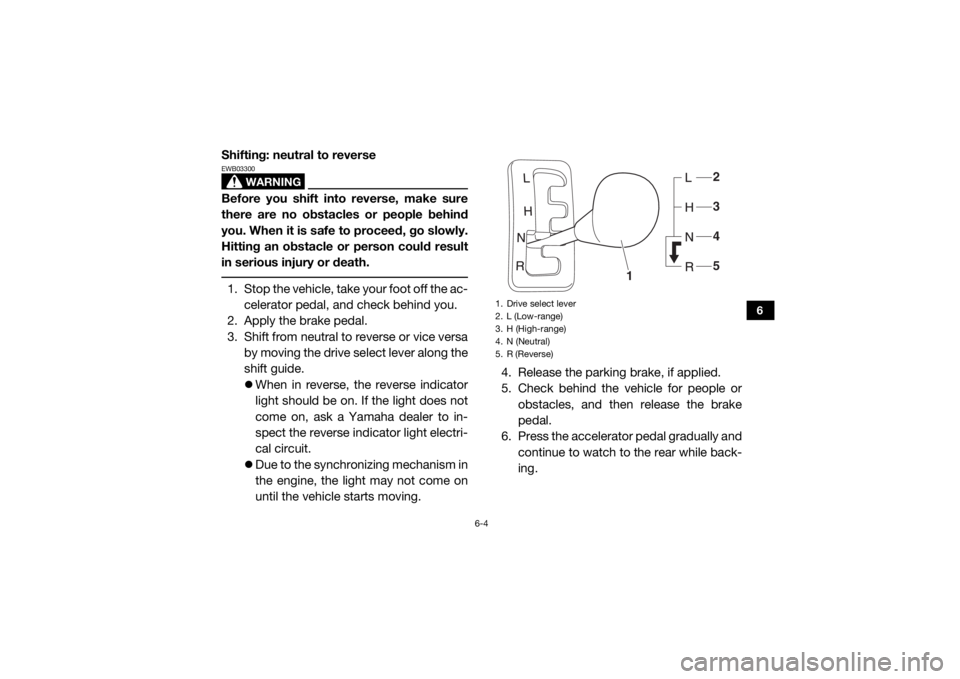
6-4
6
Shifting: neutral to reverse
WARNING
EWB03300Before you shift into reverse, make sure
there are no obstacles or people behind
you. When it is safe to proceed, go slowly.
Hitting an obstacle or person could result
in serious injury or death. 1. Stop the vehicle, take your foot off the ac-celerator pedal, and check behind you.
2. Apply the brake pedal.
3. Shift from neutral to reverse or vice versa by moving the drive select lever along the
shift guide.
When in reverse, the reverse indicator
light should be on. If the light does not
come on, ask a Yamaha dealer to in-
spect the reverse indicator light electri-
cal circuit.
Due to the synchronizing mechanism in
the engine, the light may not come on
until the vehicle starts moving. 4. Release the parking brake, if applied.
5. Check behind the vehicle for people or
obstacles, and then release the brake
pedal.
6. Press the accelerator pedal gradually and
continue to watch to the rear while back-
ing.
1. Drive select lever
2. L (Low-range)
3. H (High-range)
4. N (Neutral)
5. R (Reverse)
1
2
5 4
3
UB857AE0.book Page 4 Monday, August 24, 2015 8:59 AM
Page 82 of 184
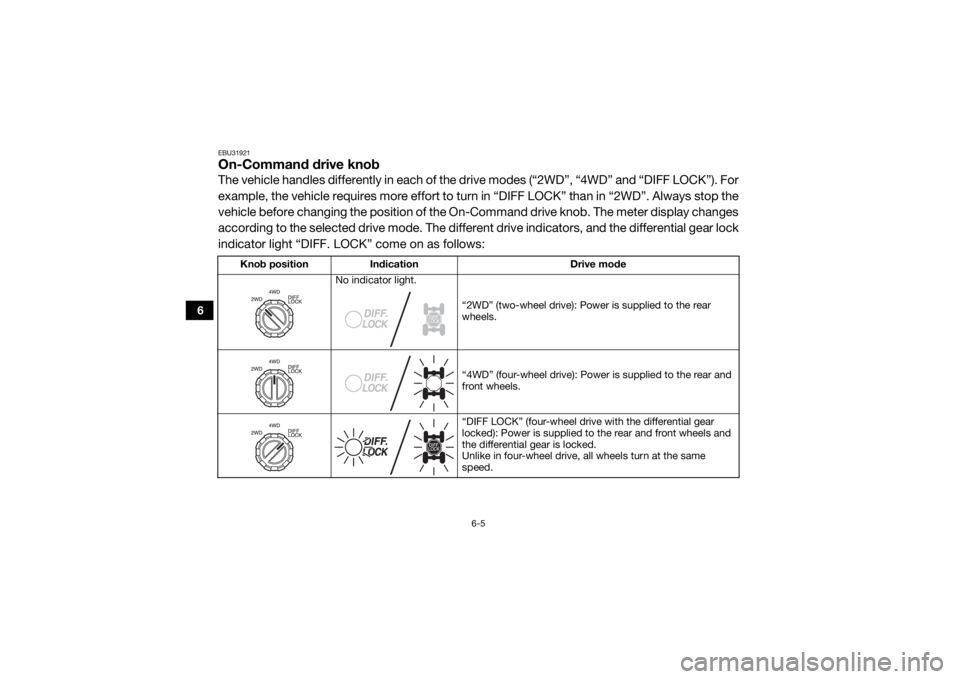
6-5
6
EBU31921On-Command drive knobThe vehicle handles differently in each of the drive modes (“2WD”, “4WD” and “DIFF LOCK”). For
example, the vehicle requires more effort to turn in “DIFF LOCK” than in “2WD”. Always stop the
vehicle before changing the position of the On-Command drive knob. The meter display changes
according to the selected drive mode. The differen t drive indicators, and the differential gear lock
indicator light “DIFF. LOCK” come on as follows:
Knob position Indication Drive mode
No indicator light.
“2WD” (two-wheel drive): Power is supplied to the rear
wheels.
“4WD” (four-wheel drive): Power is supplied to the rear and
front wheels.
“DIFF LOCK” (four-wheel drive with the differential gear
locked): Power is supplied to the rear and front wheels and
the differential gear is locked.
Unlike in four-wheel drive, all wheels turn at the same
speed.
UB857AE0.book Page 5 Monday, August 24, 2015 8:59 AM
Page 83 of 184

6-6
6
TIPWhen the knob is set to “DIFF LOCK” or “4WD”, the differential gear lock indicator and indica-
tor light will flash until the differential gear is completely locked or unlocked.
When the indicator and indicator light are flashi ng, turning the steering wheel back and forth
will help the differential gear lock to engage or disengage.
Riding before the differential gear is properly engaged or disengaged (e.g., when the indicator
and indicator light are flashing) will cause the vehicle speed to be limited until the differential
gear is completely engaged or disengaged. UB857AE0.book Page 6 Monday, August 24, 2015 8:59 AM
Page 84 of 184

6-7
6
EBU31930ParkingWhen parking, stop the engine and shift the
drive select lever into the neutral position. Ap-
ply the parking brake to help prevent the ve-
hicle from rolling. See page 7-17 for more
information on parking and parking on a
slope.EBU31940LoadingTake extra precautions when driving with a
load or trailer. Follow these instructions and
always use common sense and good judg-
ment when carrying cargo or towing a trailer.
Prepare your load or trailer
WARNING
EWB03310Improper loading or towing can increase
the risk of loss of control, an overturn, or
other accident:
Do not exceed the Maximum Loading
Limits for the vehicle (see “MAXIMUM
LOADING LIMIT” in this section and ve-
hicle labeling).
Keep weight in the cargo bed centered
side to side, and as low and as far for-
ward as possible. Top-heavy loads in-
crease the risk of overturn. Be sure
cargo is secured – a loose load could
change handling unexpectedly or strike
occupants.
Do not exceed the maximum tongue
weight.
Make sure the load does not interfere
with your control or ability to see where
you are going.
Tie down cargo in the trailer securely.
Make sure cargo in the trailer cannot
move around. A shifting load can cause
an accident.
Use the hooks equipped on the cargo bed to
tie down loads.
UB857AE0.book Page 7 Monday, August 24, 2015 8:59 AM
Page 85 of 184

6-8
6
Choose a trailer hitch drawbar designed for
use with a 5 cm (2 in) receiver. (See page 4-25
for more information.)
You can measure tongue weight with a bath-
room scale. Put the tongue of the loaded trail-
er on the scale with the tongue at hitch height.
Adjust the load in the trailer, if necessary, to
reduce the weight on hitch. If you are carrying
cargo and towing a trailer, include the tongue
weight in the maximum vehicle load limit.Operating when loaded with cargo or tow-
ing a trailer
Drive more slowly than you would without a
load. The more weight you carry, the slower
you should go. Although conditions vary, it is
good practice to keep the vehicle in low gear
whenever you are carrying heavier loads or
when towing a trailer.
WARNING
EWB03320Carrying loads or towing a trailer can in-
crease the risk of loss of control, an over-
turn, or other acciden
t. To reduce the risk
of an accident:
Reduce speed, operate in low gear only,
and allow more room to stop. A heavier
vehicle takes longer to stop.
Avoid hills and rough terrain. Choose
terrain carefully. Use extreme caution
when towing or carrying a load on in-
clines.
Turn gradually and go slowly.
MAXIMUM LOADING LIMIT
Vehicle loading limit (total weight of cargo,
operator, passengers and accessories and
tongue weight): 594.0 kg (1309 lb)
Cargo bed: 272.0 kg (600 lb)
Tr a i l e r h i t c h :Pulling load (total weight of trailer and
cargo): 6664 N (680 kgf, 1500 lbf)
Tongue weight (vertical weight on trailer
hitch point): 490 N (50 kgf, 110 lbf)
UB857AE0.book Page 8 Monday, August 24, 2015 8:59 AM
Page 86 of 184

6-9
6
Pulling something other than a trailer
Yamaha recommends that loads be trans-
ported in the bed or in a trailer. If you need to
move an object a short distance use a winch
and follow the winch manufacturer’s instruc-
tions.
If you choose to use something other than a
winch use extreme caution, follow the manu-
facturer’s instructions for that product, and
only attach to the hitch or hitch bracket of the
Viking VI. WARNING! Improperly pulling can
cause serious injury or death. Never ex-
ceed the pulling load limit of the Viking VI.
Avoid pulling on inclines.
[EWB03330]
Pulling objects on the ground can be more
hazardous than pulling a trailer. It may be dif-
ficult to predict how the load will affect vehicle
operation. That effect could also change de-
pending upon terrain or what obstacles might
be in the object’s path.UB857AE0.book Page 9 Monday, August 24, 2015 8:59 AM
Page 87 of 184

7-1
7
EBU31950
BASIC GUIDE FOR SAFE USE
EBU31960As a Viking VI owner you are responsible for
the safe and proper operation of this vehicle.
Read this chapter and review the safety in-
structions in Chapter 2 before operating the
vehicle. Use these chapters and the labels on
the vehicle to instruct new operators and pas-
sengers. Do not allow anyone else to operate
the vehicle or ride as a passenger if you are
unsure that he/she is willing and able to follow
these instructions.
WARNING
EWB03340Follow these instructions to reduce your
risk of an accident and to reduce the risk
of serious injury or death in the event of an
accident.
EBU33210KNOW YOUR VEHICLEThis off-road vehicle will handle and maneuver
differently from cars, ATVs, go-carts, golf-cars
and grounds-keeping vehicles. The Viking VI
has higher ground clearance and other fea-
tures to handle rugged terrain, and, as a result,
can overturn in situations where some vehicles
may not. This would include vehicles made pri-
marily for pavement, roads, improved paths, or
grounds-keeping. If you do not use care in ma-
neuvering the Viking VI, you can cause it to roll
over even on flat, open areas.
Doing things with a Viking VI that some peo-
ple do for thrills in other vehicles (such as
sideways sliding, skidding, back-wheel slid-
ing, or donuts) have led to side rollovers.
These rollovers can result in crushed limbs
and other serious injuries or death to drivers
or passengers.
As the owner/operator, it is your responsibility
to protect yourself and your passengers from
accidents, including rollovers. The Viking VI
UB857AE0.book Page 1 Monday, August 24, 2015 8:59 AM
Page 88 of 184
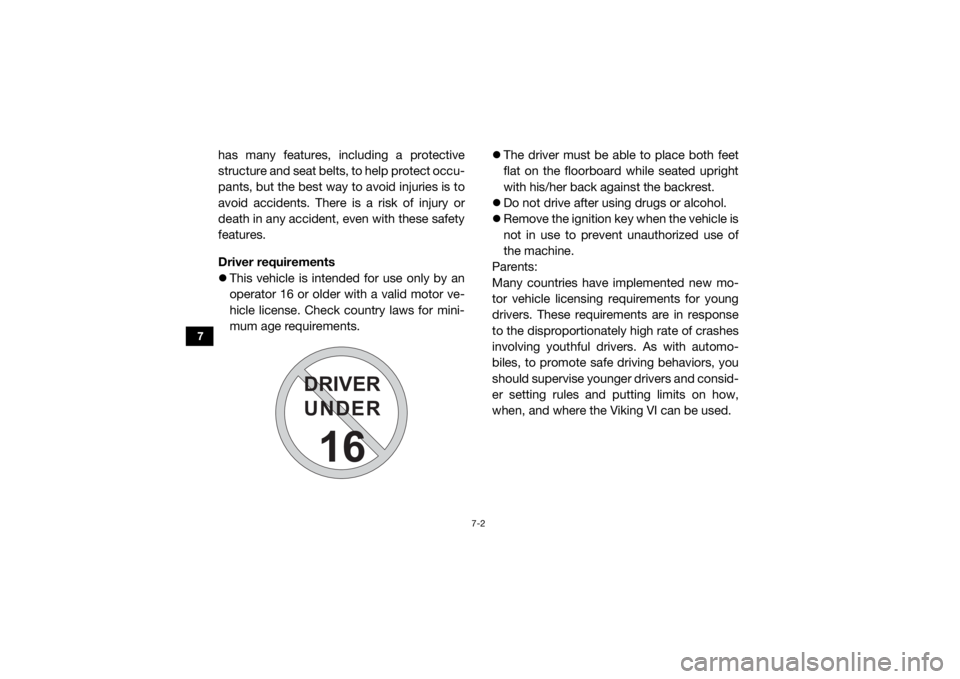
7-2
7
has many features, including a protective
structure and seat belts, to help protect occu-
pants, but the best way to avoid injuries is to
avoid accidents. There is a risk of injury or
death in any accident, even with these safety
features.
Driver requirements
This vehicle is intended for use only by an
operator 16 or older with a valid motor ve-
hicle license. Check country laws for mini-
mum age requirements.
The driver must be able to place both feet
flat on the floorboard while seated upright
with his/her back against the backrest.
Do not drive after using drugs or alcohol.
Remove the ignition key when the vehicle is
not in use to prevent unauthorized use of
the machine.
Parents:
Many countries have implemented new mo-
tor vehicle licensing requirements for young
drivers. These requirements are in response
to the disproportionately high rate of crashes
involving youthful drivers. As with automo-
biles, to promote safe driving behaviors, you
should supervise younger drivers and consid-
er setting rules and putting limits on how,
when, and where the Viking VI can be used.
DRIVER
UNDER
16
UB857AE0.book Page 2 Monday, August 24, 2015 8:59 AM
Page 89 of 184
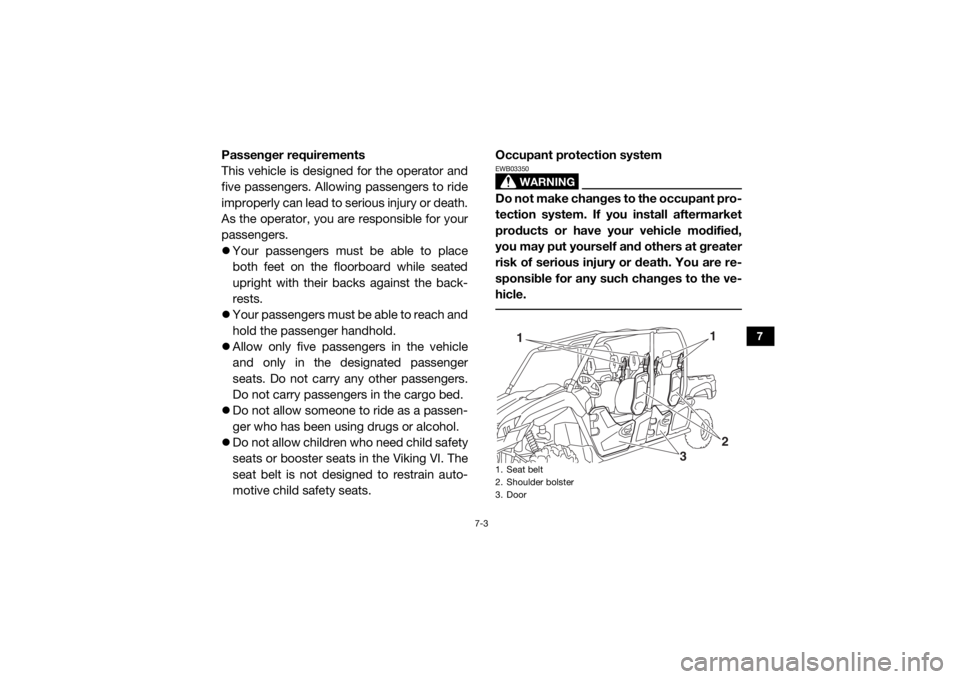
7-3
7
Passenger requirements
This vehicle is designed for the operator and
five passengers. Allowing passengers to ride
improperly can lead to serious injury or death.
As the operator, you are responsible for your
passengers.
Your passengers must be able to place
both feet on the fl oorboard while seated
upright with their backs against the back-
rests.
Your passengers must be able to reach and
hold the passenger handhold.
Allow only five passengers in the vehicle
and only in the designated passenger
seats. Do not carry any other passengers.
Do not carry passengers in the cargo bed.
Do not allow someone to ride as a passen-
ger who has been using drugs or alcohol.
Do not allow children who need child safety
seats or booster seats in the Viking VI. The
seat belt is not designed to restrain auto-
motive child safety seats. Occupant protection system
WARNING
EWB03350Do not make changes to the occupant pro-
tection system. If you install aftermarket
products or have your vehicle modified,
you may put yourself and others at greater
risk of serious injury or death. You are re-
sponsible for any such changes to the ve-
hicle. 1. Seat belt
2. Shoulder bolster
3. Door
3
2
1
1
UB857AE0.book Page 3 Monday, August 24, 2015 8:59 AM
Page 90 of 184
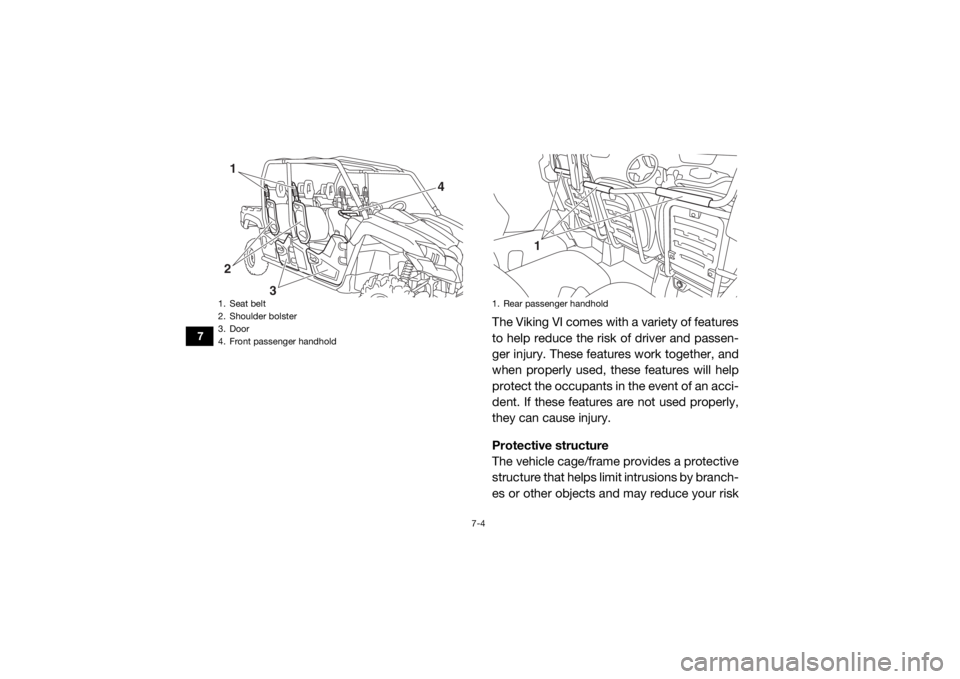
7-4
7
The Viking VI comes with a variety of features
to help reduce the risk of driver and passen-
ger injury. These features work together, and
when properly used, these features will help
protect the occupants in the event of an acci-
dent. If these features are not used properly,
they can cause injury.
Protective structure
The vehicle cage/frame provides a protective
structure that helps limit intrusions by branch-
es or other objects and may reduce your risk
1. Seat belt
2. Shoulder bolster
3. Door
4. Front passenger handhold
34
2 1
1. Rear passenger handhold
1
UB857AE0.book Page 4 Monday, August 24, 2015 8:59 AM